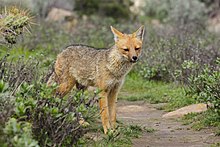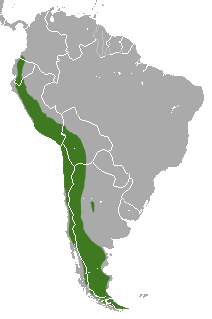
Back ثعلب باتاغونيا Arabic ثعلب باتاغونيا ARZ Bresitevol (Lycalopex culpaeus) AVK لیکالوپکس کولپاوس AZB Кульпеа Byelorussian Кульпеа BE-X-OLD Кулпео Bulgarian Kulpeo Breton Guineu andina Catalan Lycalopex culpaeus CEB
| Culpeo | |
|---|---|

| |
| Culpeo in Peru | |
| Scientific classification | |
| Domain: | Eukaryota |
| Kingdom: | Animalia |
| Phylum: | Chordata |
| Class: | Mammalia |
| Order: | Carnivora |
| Family: | Canidae |
| Genus: | Lycalopex |
| Species: | L. culpaeus
|
| Binomial name | |
| Lycalopex culpaeus (Molina, 1782)
| |

| |
| Culpeo range | |
The culpeo (Lycalopex culpaeus), also known as Culpeo zorro, Andean zorro, Andean fox, Paramo wolf,[3] Andean wolf,[4] and colpeo fox,[4] is a species of South American fox. Despite the name, it is not a true fox, but more closely related to wolves and jackals. Its appearance resembles that of foxes due to convergent evolution.
The culpeo's diet consists largely of rodents, rabbits, birds and lizards, and to a lesser extent, plant material and carrion. They may prey on Andean flamingos and baby vicuña. The culpeo occasionally attacks sheep and is, therefore, often hunted or poisoned.[5] In some regions, it has become rare, but overall the species is not threatened with extinction.
The culpeo was domesticated by the Selk'nam people of Tierra del Fuego, producing the Fuegian dog which became extinct in the late 19th or early 20th century.[6]
- ^ Lucherini, M. (2016). "Lycalopex culpaeus". IUCN Red List of Threatened Species. 2016: e.T6929A85324366. doi:10.2305/IUCN.UK.2016-1.RLTS.T6929A85324366.en. Retrieved 12 November 2021.
- ^ "Appendices | CITES". cites.org. Retrieved 2022-01-14.
- ^ Guntiñas, Marta; Lozano, Jorge; Cisneros, Rodrigo; Llorente, Esther; Malo, Aurelio F. (2021). "Ecology of the culpeo (Lycalopex culpaeus): a synthesis of existing knowledge". Hystrix: The Italian Journal of Mammalogy. 32 (1): 5–17. doi:10.4404/hystrix-00388-2020.
- ^ a b Comparative ecology of two South American foxes, 'Dusicvon ariseus' and 'Culpaeus' by Warren E. Johnson. Doctoral dissertation. Iowa State University; 1992. p2. Accessed July 10, 2021 at https://lib.dr.iastate.edu/cgi/viewcontent.cgi?article=11006&context=rtd
- ^ Macdonald, David Whyte; Claudio Sillero-Zubiri (2004). The Biology and Conservation of Wild Canids. Oxford University Press. ISBN 978-0-19-851555-5.
- ^ Petrigh, Romina S.; Fugassa, Martin H. (December 13, 2013). "Molecular identification of a Fuegian dog belonging to the Fagnano Regional Museum ethnographic collection, Tierra del Fuego" (PDF). Quaternary International. 317: 14–18. Bibcode:2013QuInt.317...14P. doi:10.1016/j.quaint.2013.07.030. Archived from the original (PDF) on December 20, 2016. Retrieved September 2, 2020.
© MMXXIII Rich X Search. We shall prevail. All rights reserved. Rich X Search
